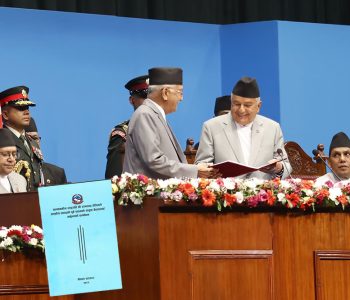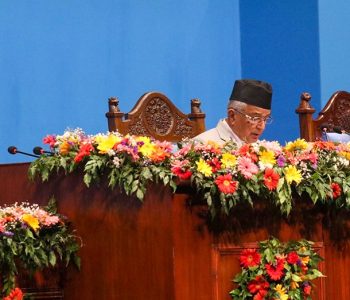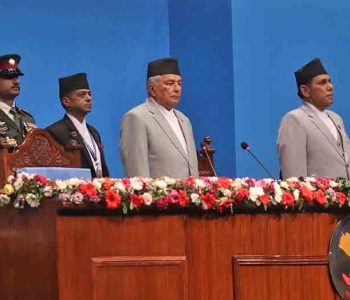MCC’s uncertain future sparks debate on Nepal’s infrastructure ambitions and cost concerns

KATHMANDU: The U.S. Department of Government Efficiency (DoGE), led by billionaire entrepreneur Elon Musk, has signaled the potential termination of the Millennium Challenge Corporation (MCC), casting uncertainty over Nepal’s $500 million U.S.-funded infrastructure projects.
The looming closure has sparked intense discussions about Nepal’s ability to independently sustain these initiatives, manage escalating costs, and navigate the broader implications of U.S. foreign policy on its development agenda.
The MCC has been a cornerstone of Nepal’s energy infrastructure, supporting a 315-km 400 kV transmission network, a Nepal-India cross-border transmission line from New Butwal to Gorakhpur, and three new 400 kV substations in Ratamate, New Damauli, and New Butwal.
However, with the DoGE notifying MCC staff that the program could end abruptly, Nepal faces critical questions about project continuity, cost management, and the influence of U.S. policy on its development trajectory.
Cost Concerns Amplified by MCC’s Framework
The MCC-funded projects in Nepal have drawn criticism for their high costs, driven by U.S.-centric procurement guidelines and excessive expenses on social and environmental reports. Critics argue that these inflated costs, embedded in the MCC’s framework, set a precedent that could drive up expenses for Nepal’s other infrastructure projects.
“The MCC’s approach includes unnecessary social and environmental reporting that inflates budgets,” said a project analyst. “This could trigger a ripple effect, pushing up costs for similar projects across Nepal.”
Experts like Netra Prasad Gyawali, former CEO of the National Transmission Grid Company, argue that Nepal could significantly reduce expenses by revising engineering procurement and tender processes to align with local standards.
“The American guidelines include costly social components that don’t align with our context. By adopting our own procurement framework, we can lower per-kilometer costs without sacrificing quality,” Gyawali explained. He suggested that for projects yet to be contracted, Nepal could modify procurement to optimize costs, a critical step given the MCC’s potential closure.
However, some experts caution that transitioning to local management could introduce inefficiencies, potentially offsetting cost savings. The debate underscores the need for meticulous planning to balance cost reduction with quality assurance, especially as Nepal grapples with the MCC’s expensive legacy.
U.S. Foreign Policy and Project Delays
The MCC’s uncertain fate in Nepal is seen by some as a manifestation of raw U.S. foreign policy, which has historically complicated and delayed projects in the country. The program’s stringent requirements and geopolitical undertones have lingered as points of contention, hampering progress and fueling public skepticism.
“This is U.S. foreign policy at play, imposing conditions that slow down projects and create dependencies,” said a development expert. The potential termination of MCC funding reinforces these concerns, highlighting Nepal’s vulnerability to external policy shifts.
Progress Amid Uncertainty
Despite the challenges, MCA-Nepal has made strides. Land compensation for the Ratamate substation is complete, and a $38.8 million contract for the New Damauli substation has been awarded to India’s Techno Electric and Engineering Limited. With many contracts still pending, Nepal has an opportunity to revise procurement strategies for unallocated projects, potentially saving millions.
Chirantan Bikram Rana, CEO of NEA Engineering Company, emphasized Nepal’s readiness to take charge. “We can optimize costs to fit our budget while maintaining international standards. Our work on the 400 kV Inaruwa-Dhalkebar-Hetauda line proves our capability,” Rana said. He noted that ongoing projects, like the Phukot-Bethan-Dododhara line, demonstrate Nepal’s growing expertise in managing high-voltage infrastructure.
Gyawali added that the MCC’s potential exit was anticipated. “There was always a suspicion that the U.S. might pull out mid-project, and that fear is now being realized,” he said. For uncontracted projects, Nepal could adopt cost-effective measures without compromising quality, ensuring the completion of critical infrastructure.
Strategic Implications and the Path Forward
The MCC’s potential termination exposes Nepal’s reliance on foreign funding and the risks of aligning with U.S.-driven frameworks. Critics warn that the MCC’s high-cost model could inflate budgets for future projects, straining Nepal’s resources. At the same time, the situation presents an opportunity for Nepal to assert greater control over its development agenda by leveraging local expertise and revising procurement practices.
Experts urge the government to initiate contingency planning immediately, exploring alternative funding sources and technical partnerships. The successful completion of MCC projects—whether U.S.-funded or locally managed—is critical for Nepal’s energy security and regional connectivity, particularly through the cross-border transmission line with India.
As Nepal navigates this uncertainty, the focus must remain on strategic cost optimization, transparent procurement, and capacity building to avoid delays or cost overruns. The MCC saga, shaped by U.S. foreign policy and its costly framework, may serve as a catalyst for Nepal to build a more self-reliant infrastructure ecosystem.
However, the path forward demands careful deliberation, decisive action, and a commitment to shielding Nepal’s development goals from external pressures.













Facebook Comment